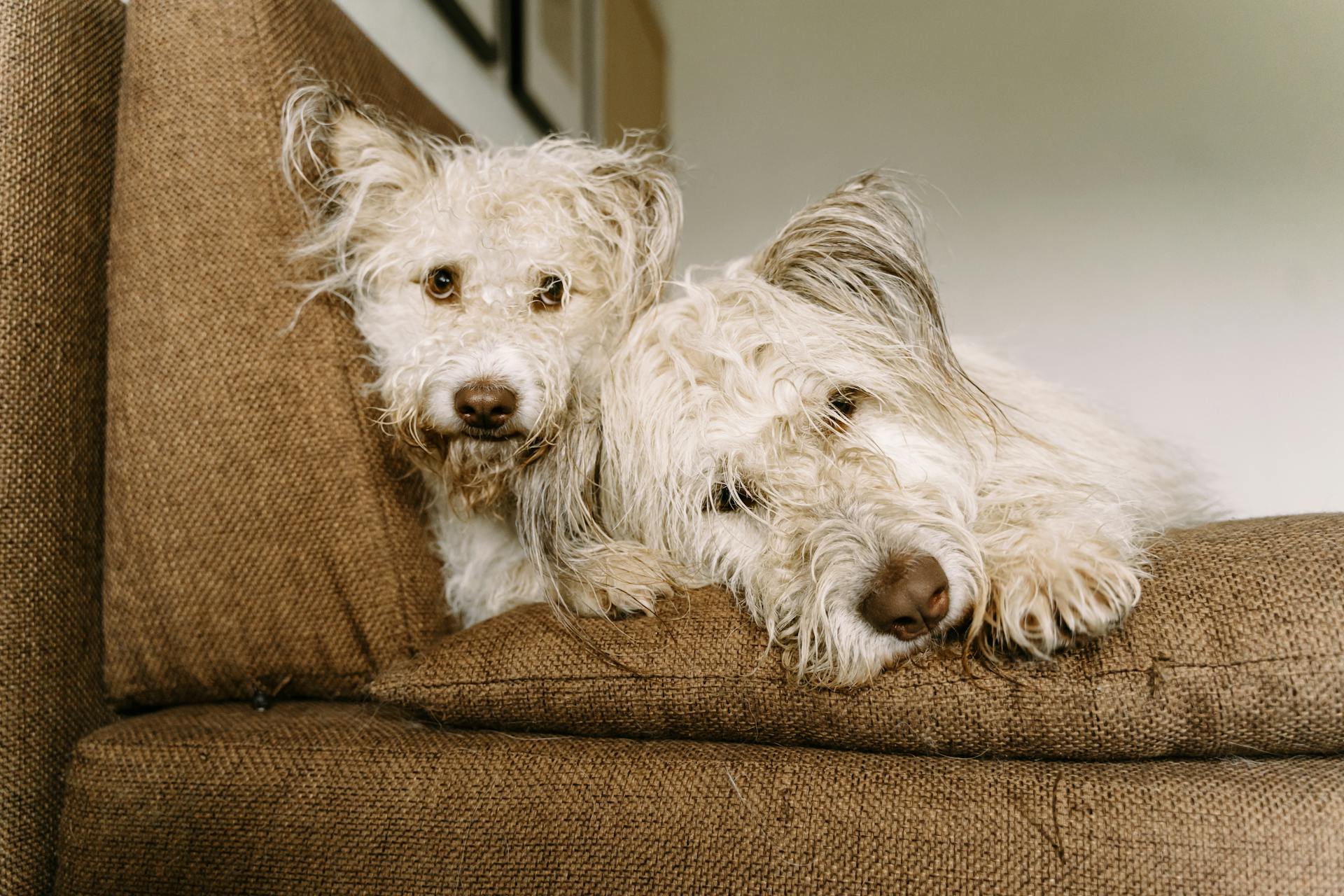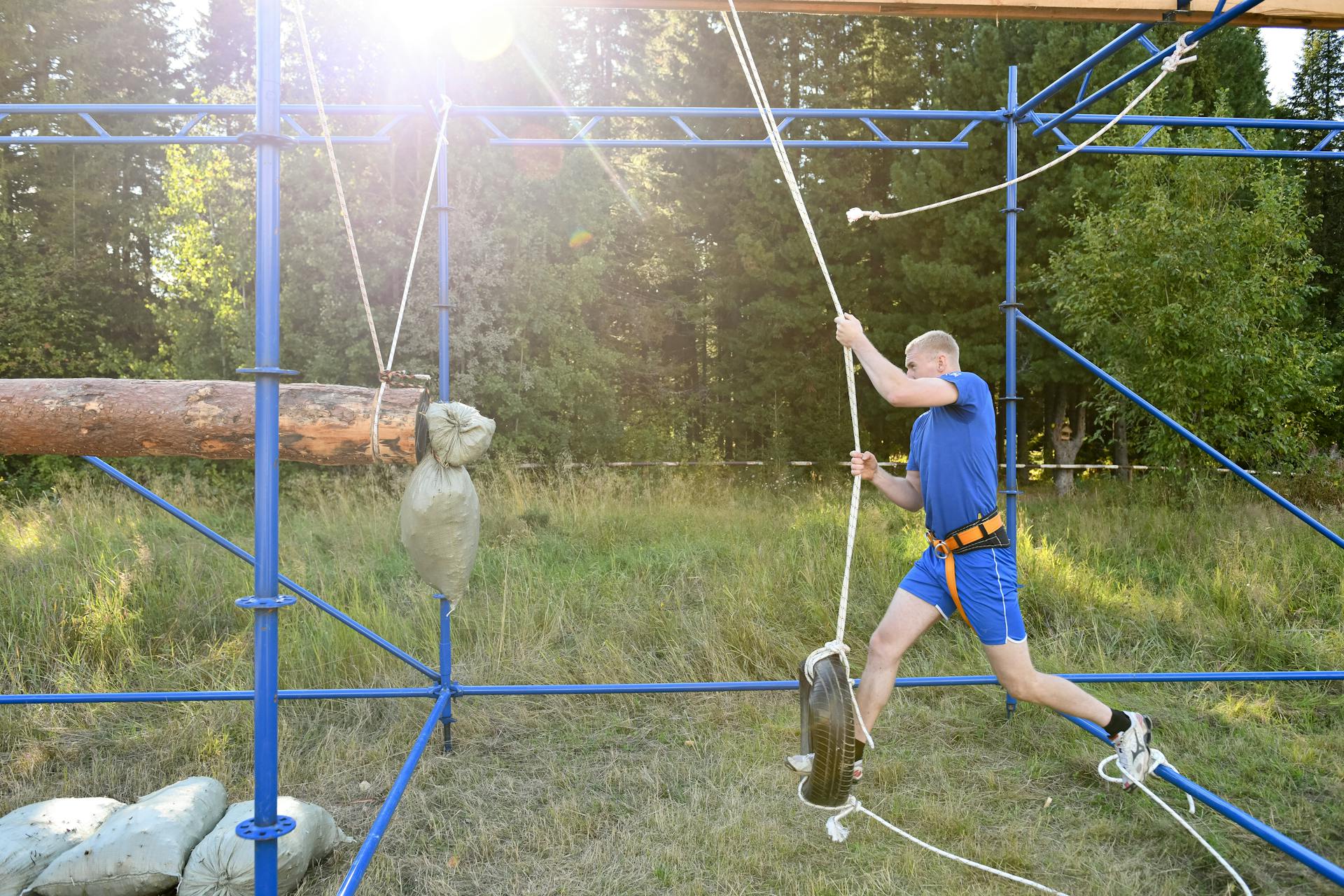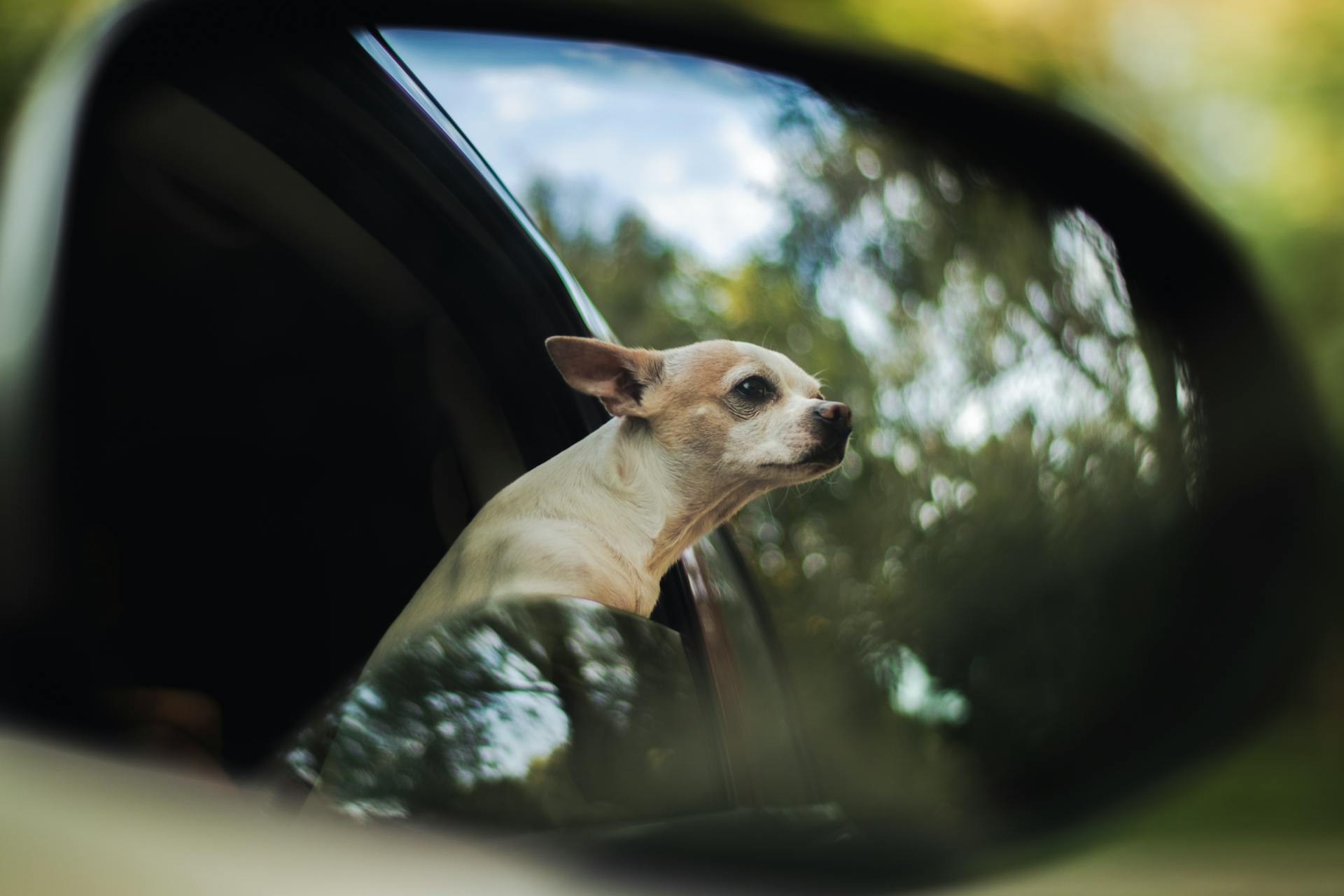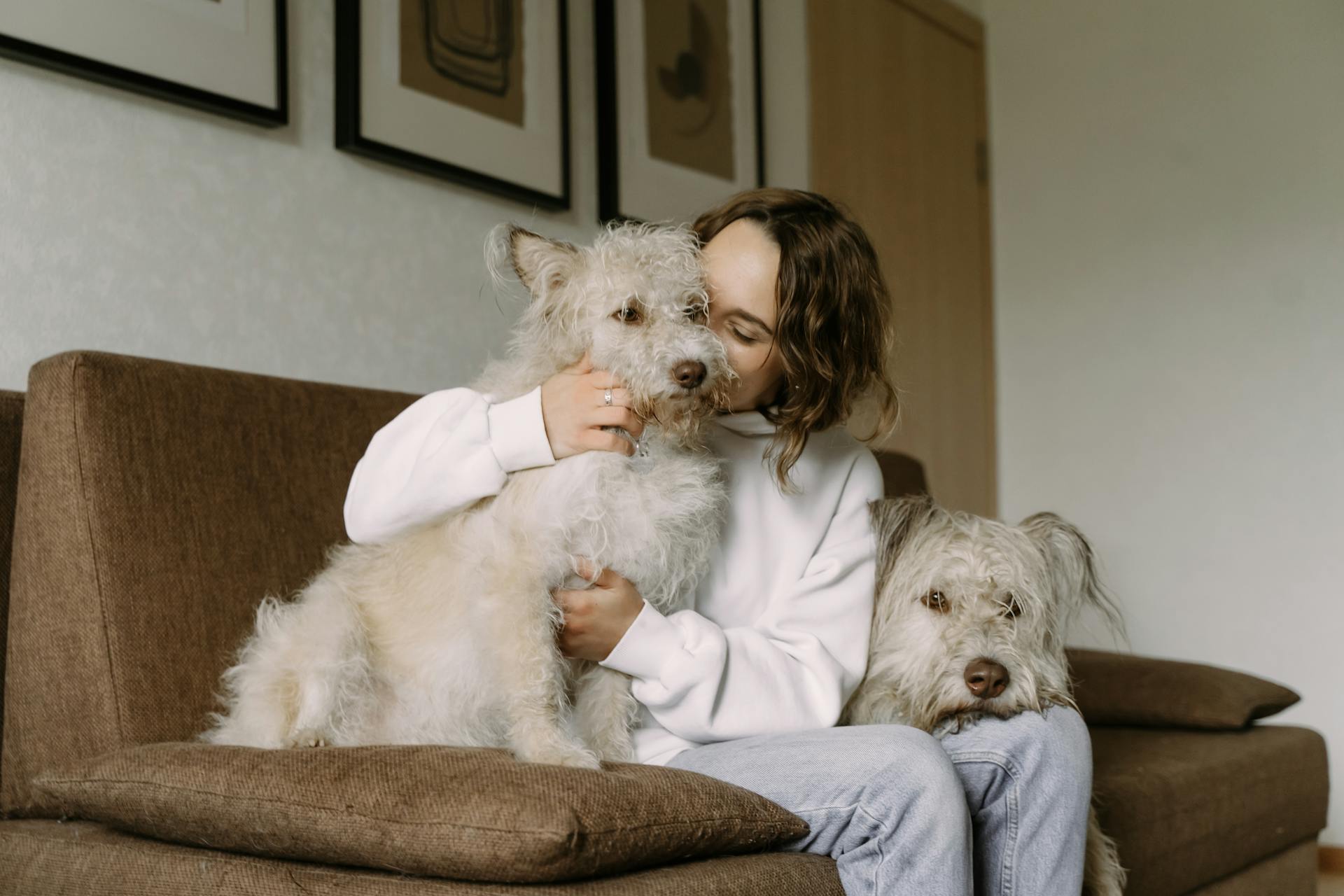
Some breeds are more prone to separation anxiety than others. The German Shepherd is one of the top breeds that experience separation anxiety.
These dogs are often highly intelligent and sensitive, which can make it difficult for them to cope with being left alone. They may become destructive, bark excessively, or even try to escape.
The Labrador Retriever is another breed that commonly struggles with separation anxiety. They are known for their loyalty and attachment to their owners.
For your interest: Dogs with Separation Anxiety Breeds
What Is Separation Anxiety in Dogs?
Separation anxiety in dogs is a real and serious issue. It's a condition where your dog exhibits extreme stress from the time you leave them alone until you return.
Dogs with separation anxiety will act as if they're terrified to be in the house on their own. This is comparable to a panic attack.
You can think of separation anxiety as an intense emotional response to being left behind. It's not something you can directly ask your dog about, but you can recognize the symptoms.
The good news is that many of the recommendations for preventing separation anxiety are things you may already be doing, such as puppy training, socialization, crate training, and teaching your puppy how to enjoy being alone.
Recommended read: Puppy Mill Dogs Behavior
Recognizing and Understanding the Problem
Dogs with separation anxiety can exhibit a range of symptoms, including barking, whining, or howling to alert their owners of their presence. This behavior is not just a simple bark to let you know they need to go out or that the mailman is at the door.
According to the American Kennel Club, some common signs of separation anxiety in dogs include hyper greetings, where they become extremely attached to their owners upon their return home. This can manifest as excessive salivation, drooling, or panting.
Destructive behavior, such as chewing on furniture or destroying household items, is also a common symptom of separation anxiety. This is typically a destructive release of nervous energy that would benefit from therapy or medication.
Here are some common signs of separation anxiety in dogs:
- Anxious behaviors like pacing, whining, or trembling while you’re gone or as you prepare to leave.
- Excessive barking or howling.
- Destructive acts, such as chewing or digging, particularly around doors or windows.
- Accidents in the house – urinating or defecating.
- Excessive salivation, drooling, or panting.
- Desperate and prolonged attempts to escape confinement, potentially ending in serious injury.
It's essential to note that separation anxiety is not the same as boredom or inadequate training. If your dog is exhibiting destructive behavior, it's crucial to rule out these possibilities by ensuring they are fully trained and understand good manners.
What Causes in Puppies
Puppies that have never previously been left alone may be more prone to separation anxiety. This can be due to a lack of exposure to being alone, which can cause anxiety when they are left behind.
Traumatic events, such as a house being robbed, can also trigger separation anxiety in puppies. This is because the experience can be extremely frightening and lead to anxiety in the future.
Changes in a puppy's life, such as a sudden switch in schedule or a move to a new house, can also contribute to separation anxiety. This can cause stress and anxiety in a puppy's daily life.
A lack of daily exercise has even been linked to separation anxiety in puppies. Regular physical activity can help reduce stress and anxiety in puppies.
It's also possible that a puppy's personality can play a role in their likelihood of developing separation anxiety. Some puppies may be more clingy than others, which can increase their risk of separation anxiety.
Recommended read: House Training Adult Dog
What Are the Signs of?
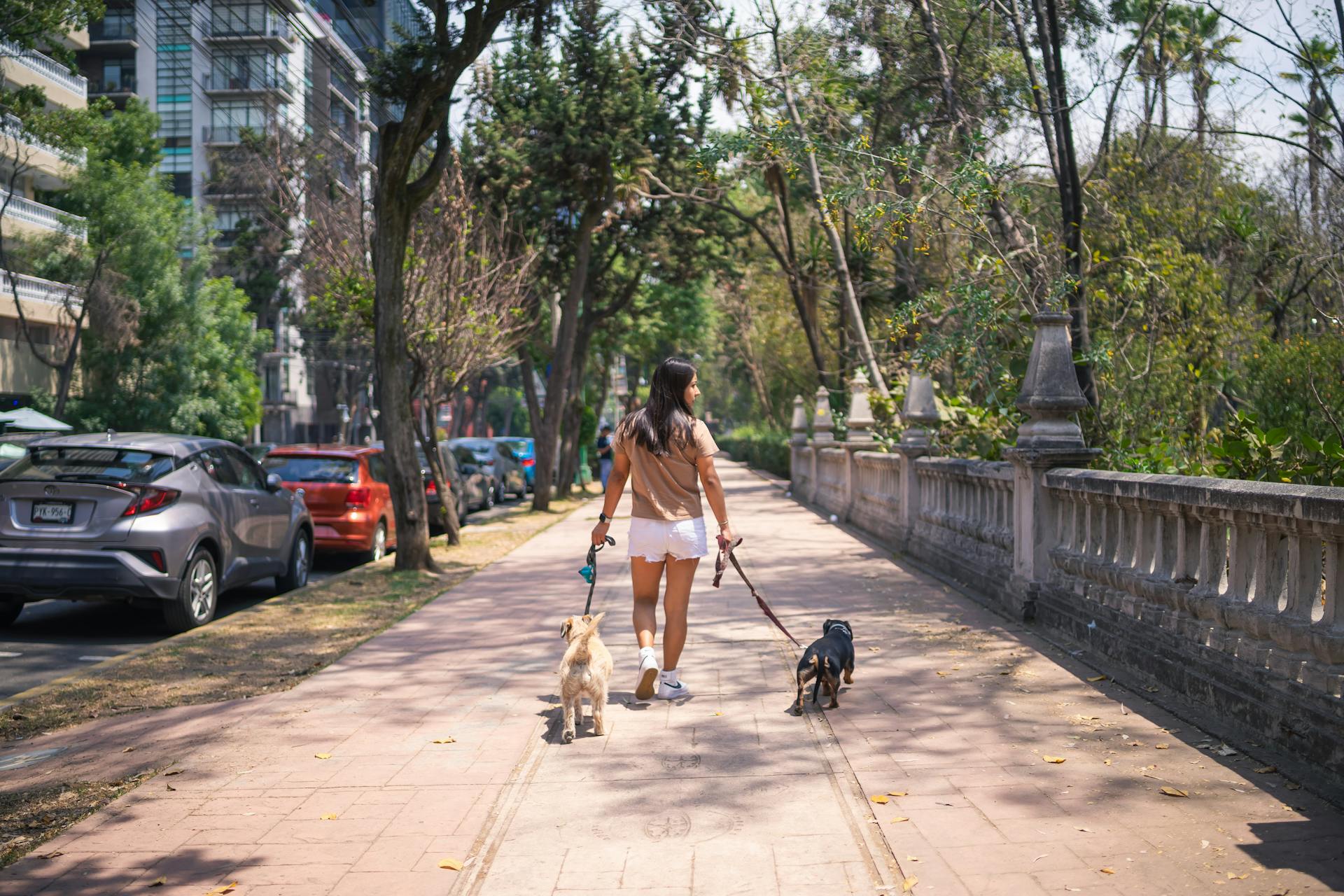
Recognizing the signs of separation anxiety in dogs is crucial to understanding the problem.
Dogs can exhibit stress in many ways, so there is no one defining sign of separation anxiety. Instead, there are a variety of symptoms. One or two of them, especially if they only happen occasionally, may not be a sign of puppy separation anxiety. But if your puppy shows multiple symptoms on a regular basis, they may be suffering from separation anxiety.
Some common behaviors your dog may exhibit include anxious behaviors like pacing, whining, or trembling while you're gone or as you prepare to leave. Excessive barking or howling is also a sign of separation anxiety. Destructive acts, such as chewing or digging, particularly around doors or windows, can be a sign of the dog's stress. Accidents in the house – urinating or defecating – can also be a symptom. Excessive salivation, drooling, or panting can also be a sign of separation anxiety.

Here are some specific signs of separation anxiety in dogs, according to the American Kennel Club:
- Barking, whining or howling to alert – More than just a bark to let you know they have to go out or that the ever mysterious mailman has made a delivery.
- Hyper Greetings – While you’ve been away your dog has been panicking. When you arrive home your dog might go to the bathroom upon seeing you, jump on you or become extremely attached to you.
- Destructive Behavior – This goes beyond chewing on a pair of shoes. Has your dog ever gone into full demolition mode destroying furniture, pillows, clothing and anything else in his/her way?
- Excessive Salivation, Drooling, or Panting – When you reach for your keys a dog exhibiting separation anxiety might become severely distressed and begin drooling and panting uncontrollably.
It's essential to note that these behaviors can be symptoms of other issues, such as boredom or inadequate training. Before labeling your dog's behavior as separation anxiety, make sure it's not a case of inadequate training or a lack of clear structure.
Breeds Prone to Separation Anxiety
Some breeds are more prone to separation anxiety than others.
The Border Collie, for instance, is known to be highly intelligent and energetic, which can make them more susceptible to separation anxiety.
They require constant mental and physical stimulation, and when left alone, they can get destructive.
German Shepherds are another breed that can suffer from separation anxiety.
Their strong loyalty to their owners can sometimes translate to anxiety when left behind.
They need consistent training and exercise to help manage their separation anxiety.
Labradors are also known to experience separation anxiety.
Their high energy levels and strong attachment to their owners can make them feel anxious when left alone.
Chow Chows are a breed that can be prone to separation anxiety due to their independent nature.
They can become destructive when left alone for extended periods.
Dalmatians are another breed that can suffer from separation anxiety. Their high energy levels and strong attachment to their owners can make them feel anxious when left alone.
Cocker Spaniels are a breed that can experience separation anxiety due to their sensitive nature.
They can become anxious and destructive when left alone for extended periods.
Shetland Sheepdogs, also known as Shelties, are a breed that can be prone to separation anxiety.
Their high energy levels and strong attachment to their owners can make them feel anxious when left alone.
Their independent nature can also contribute to their separation anxiety.
Poodles are another breed that can experience separation anxiety due to their sensitive nature.
They can become anxious and destructive when left alone for extended periods.
Doberman Pinschers are a breed that can be prone to separation anxiety.
Their strong loyalty to their owners can sometimes translate to anxiety when left behind.
Their high energy levels also contribute to their separation anxiety.
For another approach, see: Boarding an Anxious Dog
Managing Separation Anxiety
Crate training can be a great tool for managing separation anxiety, but it's essential to teach your dog to associate their crate with positive experiences. This can be achieved by feeding them in their crate, using crate time as a pseudo 'place' command during training sessions, and making the 'kennel' command part of playing tug.
Desensitization and counter-conditioning are also crucial in helping your dog become comfortable with separation. This can be done by leaving them for short periods and gradually increasing the time, using high-value treats to associate with your departure, and making your departure routine less distressing by desensitizing your puppy to the signs you're about to go out.
Creating a home separation routine, where you ignore your dog for short periods, can also help them learn to entertain themselves. This can be done by placing a signal, such as an uncommon book, on the dinner table and ignoring your dog for 5 minutes. Gradually increasing the time and adding distance and isolation to this routine can help your dog become more comfortable with being alone.
Take a look at this: Dogs Getting Sick from Dog Food
Here are some steps to help your dog cope with separation anxiety:
- Teach your dog to associate their crate with positive experiences.
- Desensitize your dog to your departure routine.
- Create a home separation routine.
- Gradually increase the time and distance of your separation routine.
It's also essential to control the emotional state of your dog when you leave and return home. Avoid getting your dog excited before you leave, as this can create frustration and make separation anxiety worse. Instead, give your dog time to adjust to the fact that you are leaving, and return home when they are in an emotionally neutral state.
For your interest: Dog Training in Home
What Can I Do About It?
It's exhausting to come home to destruction and upsetting to see your puppy in such distress, so it's time to take action.
Desensitization and counter-conditioning are key to teaching your puppy to be comfortable with time away from you. Start by leaving them for very short periods of time and gradually lengthen the amount of time you're gone.
You can make your departure routine less distressing by desensitizing your puppy to the signs you're about to go out, like picking up your keys or putting on your coat. This can help them look forward to your departure rather than panicking.
Tossing your puppy a high-value treat right before you touch your keys or coat can help them associate these signs with something positive. In time, they will look forward to the signs you're about to leave rather than panicking.
Using a high-value treat they really love can help counteract their stress reaction when you're about to leave. This can be especially helpful if your puppy is already conditioned to go into stress mode when they know you're leaving them.
If this caught your attention, see: Signs of Prey Drive in Dogs
Emotional State Control
Managing separation anxiety requires more than just treating the symptoms, it also involves controlling the emotional state of your dog. You want your dog to be emotionally neutral when you leave, not happy or excited, as this can create the expectation of doing something fun and lead to frustration when you're away.
To avoid this, it's essential to return your dog to an emotionally neutral state when you return home. This means letting your dog calm down first before interacting with it, rather than getting it all excited when you come home.
Discover more: Home Remedies for Separation Anxiety in Dogs
Excitement and fear are closely linked biochemically, which is why it's crucial to avoid creating a huge difference in your dog's emotional state between being away and coming home. This can lead to frustration and make managing separation anxiety more challenging.
Here are some practical tips to help you control your dog's emotional state:
- Avoid getting your dog excited before you leave by not creating a big fuss or giving it treats.
- Return your dog to an emotionally neutral state when you return home by letting it calm down first.
- Use high-value treats only for important lessons and rewards, and not as a way to get your dog excited.
- Desensitize your puppy to the signs you're about to leave, such as picking up your keys or putting on your coat, by tossing them a high-value treat before you touch them.
By following these tips, you can help your dog develop a more stable emotional state and reduce the likelihood of separation anxiety.
Exercise
Exercise plays a crucial role in managing separation anxiety in puppies. A tired, contented dog who's had a brisk walk and playtime with you is more likely to settle down when you leave.
Puppies with a lot of energy, especially large breeds, need regular physical exercise to burn off steam. This helps prevent restlessness and anxiety.
Training sessions, puzzle toys, and cognitive games are excellent ways to engage your puppy's mental muscles. A brain workout can be just as exhausting as a physical one.
Adjustment Time
Adjustment Time is crucial when it comes to helping your dog cope with separation anxiety.
Creating a consistent routine can help your dog feel more secure. This means doing the same things every time you leave, like putting your coat on, grabbing your keys, and tying your shoes.
Sitting down for 5 minutes before leaving can give your dog time to adjust to the fact that you're leaving. This simple ritual can make a big difference in your dog's behavior.
If you need to leave outside your regular schedule, spend some quality time with your dog an hour before you go. This could be as simple as playing with them, giving them a treat, or just cuddling.
Here are some specific things you can do to help your dog adjust:
- Give your dog time to adjust to the fact that you're leaving.
- Spent quality time with your dog before leaving, especially on weekends.
Remember, the goal is to get your dog mentally tired and fulfilled. By taking the time to adjust and calm them down, you can help reduce separation anxiety and make your dog feel more secure.
Frequently Asked Questions
Can separation anxiety in dogs be cured?
Separation anxiety in dogs can be managed and reduced with the right behavior modification program and, in some cases, medication. While it may not be fully "cured", owners can take proactive steps to prevent or alleviate their dog's separation anxiety.
Sources
- https://www.miznerbioscience.com/top-4-dog-breeds-most-likely-to-suffer-from-separation-anxiety/
- https://www.akc.org/expert-advice/training/dog-separation-anxiety/
- https://www.countryliving.com/uk/wildlife/dog-breeds/a37125946/dog-breeds-suffer-separation-anxiety/
- https://kradlemypet.com/blogs/calming-dog-blog/10-dog-breeds-most-likely-to-have-separation-anxiety
- https://happydogtraining.info/behavior/separation-anxiety-in-dogs/
Featured Images: pexels.com
